Menu
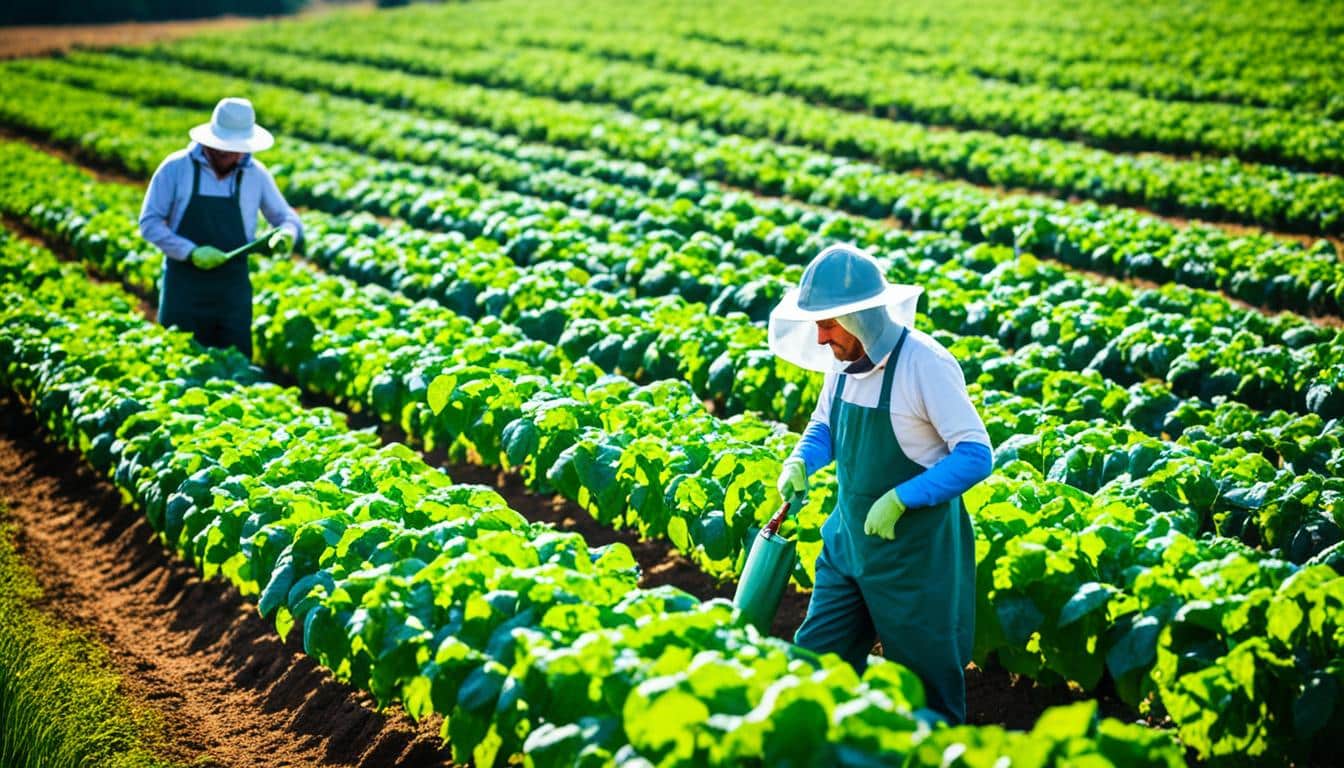
The organic food market’s sales rose to over $56 billion in the US in 2020. This was a 12% increase from 2019, showing a big success. But, organic farming faces tough and unique challenges.
Those doing organic farming must follow strict rules and grow crops in specific ways. They have to deal with more obstacles than traditional farmers. Even with new methods like cover crops, organic farmers still face many problems.
Challenges include keeping weeds at bay and making sure the soil stays fertile without over-tilling. There are also big issues with pests, diseases, and the cost of making products. The changing climate makes all these challenges even harder.
Ensuring organic products are what they claim to be is also a big worry. 77% of farmers are scared of fake products. To keep organic labels real, strict rules and checks are crucial.
There’s also a big problem of not having enough diversity in the sector. This is similar to national trends. Many think the costs to get certified are too high, especially BIPOC farmers. These costs stop many from joining.
Farmers moving to organic ways need lots of help. They face many problems with making, selling, and running their farms.
For a detailed exploration of these issues, you can refer to the comprehensive report on barriers and opportunities for organic farming on the National Sustainable Agriculture Coalition’s blog.
Organic farming uses an ecological production system. It avoids synthetic chemical fertilisers and pesticides. The main aim is to support the natural way materials flow, keep ecological balance, and protect different kinds of life. Following these rules, set by the USDA, ensures the food reaches the required organic standard.
The demand for organic food by people has grown a lot. Sales of organic food were expected to hit $25 billion in 2010. But, challenges still exist. These include meeting what people want with what’s available locally.
In the U.S., organic farming is becoming more common, though it uses less land than other farming methods. It has grown notably in the production of fruits, vegetables, and organic dairy products. These areas show how flexible and successful organic farming can be. Yet, issues remain, and more work is needed to overcome them.
Canada has also seen a big increase in the organic food market, which was over $1.5 billion in 2008. This market growth is steady. To make sure organic products are really organic, the Canadian government made rules in June 2009. These rules, managed by the CFIA, are key for keeping consumer faith. They also deal with issues that slow down the growth of natural farming.
Organic farmers deal with organic crop challenges, including weed problems. In organic farming, weed control methods differ a lot from conventional ones. They use methods like cover cropping and intercropping. These ways work well but can be expensive and need a lot of work. This can make it hard to keep managing production costs low.
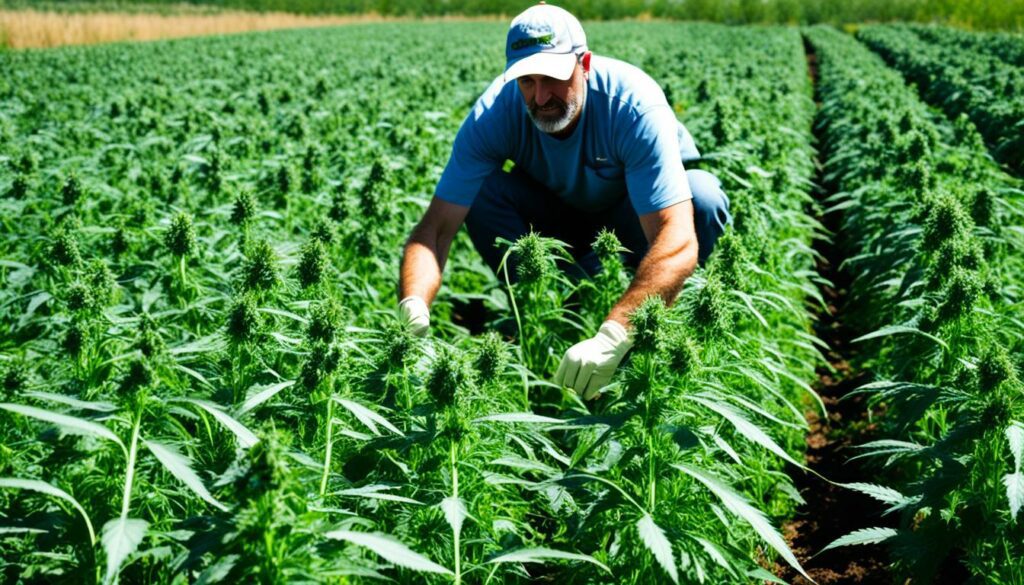
Plants like bindweed, Canada thistle, and quackgrass spread quickly through their roots. Organic farmers use methods like putting fast-growing plants close together to beat these tough weeds. They also sow cover crops that stop weed seeds from growing.
To avoid a big weed problem, farmers plant and spread their crops at just the right times. They also sometimes use heat to kill weeds before they show up. They might use organic herbicides too, as they’re strong but don’t harm the environment as much.
The cost of organic weed management is a big issue for farmers. They might spend more keeping weeds away than farmers who use chemicals. Things like planting more closely and mulching can help, but they’re still more work and money than conventional ways. The research into better organic weed control also costs money, adding to the financial burden on farmers.
It’s crucial to give farmers more support so they can tackle these organic crop challenges. With better financial help and more research, we can find and use cheaper, better ways to manage weeds organically.
| Weed Type | Seeds Per Plant | Viability in Soil (Years) | Management Tactic |
|---|---|---|---|
| Redroot Pigweed | 117,000 | 80 | Cover Cropping |
| Common Purslane | 52,000 | 80 | Higher-density Plantings |
| Shepherd’s Purse | 38,000 | 80 | Cultivation Tools |
| Common Lambsquarters | 28,000 | 80 | Mulching |
| Yellow Foxtail | 12,000 | 80 | Rotational Grazing |
Keeping soil healthy and fertile is key in organic farming. Farmers use their knowledge, what they see, advice, and tests to add nutrients to the soil. This leads to different levels of soil nutrients and health on each farm.
Improving soil without synthetic items is tough. Organic farmers prefer less tillage. It helps with soil structure and fights weeds. They also plant covers or mix crops to keep weeds at bay and boost the soil’s health.Natural materials and processes are used to add nutrients to the soil. They aren’t as concentrated, so more is needed. For certification, farmers must make sure they follow the strict rules.
It’s vital to keep the right mix of nutrients in the soil. Organic farmers adjust nutrients as plants need. The main ones like nitrogen, phosphorus, and potassium must be balanced.Micronutrients are also important but not as common. They are needed in smaller amounts but are critical for plant growth.
Organic fertilizers are pricey and not always as easy to use as artificial ones. Farmers need to think carefully about how to use them. They must also make sure they fit the rules.
Here’s a detailed look at some commonly used nutrient amendments in organic farming:
| Nutrient Amendment | Key Nutrient Content | Application Benefits | Potential Issues |
|---|---|---|---|
| Alfalfa Meal | Nitrogen | Improves soil structure | May attract rodents |
| Bone Meal | Phosphorus, Calcium | Enhances root growth | Can attract animals |
| Feather Meal | Nitrogen | Slow-release fertiliser | Odour issues |
| Fish Emulsion | Nitrogen, Phosphorus | Quick nutrient boost | Strong smell |
| Manures/Composts | Various nutrients | Improves overall soil health | Requires proper management to prevent disease |
Organic farmers also use items like wood ash and blood meal. They help keep the soil fertile and are key for sustainable farming. But, they need to be used carefully.
While these additions are helpful, they can be challenging and costly for farmers. The farming sector should help these farmers. They need to find sustainable and affordable ways to keep the soil productive and healthy for the future.
Pest and disease management is a big issue in organic farming. The main problem is that farmers can’t use chemical pesticides. This leads to more pests and crop damage. But, there are new ways to deal with these challenges.
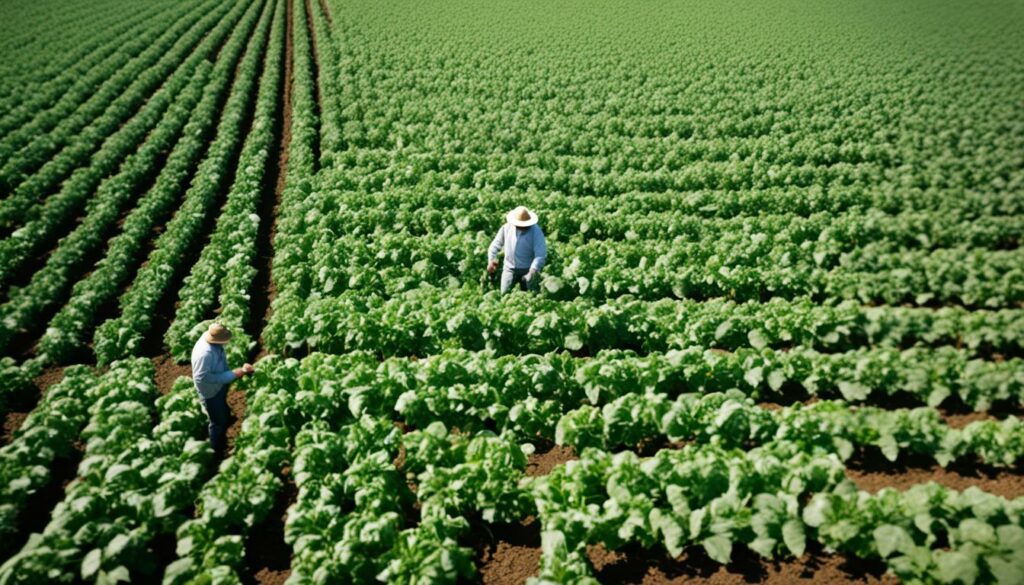
At Iowa State University, researchers got a $2 million grant. They want to find ways for plants to fight diseases from insects. They are trying out mesotunnels and low tunnels on crops.
Mesotunnels are like long tunnels held up by hoops. They help keep bad bugs away from plants. Adding special ground cover and planting things like clover and rye around crops also helps.
Early tests in Iowa look promising. Now, the study will see if these ideas work on big farms, too. They are also looking into using friendly bacteria and other natural enemies to fight diseases.
Cultural methods are also important in organic farming. This includes using scents that attract pests to traps. And encouraging the natural enemies of pests helps keep the balance.
Checking pests often is key to controlling them. Switching crops and planting varieties that bugs don’t like are also very helpful.
Switching to organic farming can be tough at first. There is usually a drop in yields. This can hit farmers hard financially. They might have spent a lot to change their methods.
Farmers must wait for the soil to adapt to the new ways. Things like biopesticides and organic manure are key. But, they need everything in the environment to work together. It can take some time for all this to boost the yields.
It’s important to invest in research for organic farming. This research helps in finding ways that suit organic farming best. It helps make up for the difference in yields between regular and organic farming.
Many organic producers use cover crops – 68%, to be exact. Compare this to just 10% of regular crop farmers. Using cover crops is a great way to maintain yields and keep the soil healthy.
We need more financial support from the government and private sector. Over the last five years, $39 billion went into organic plant breeding. This is amazing news. But, we still have organic crop challenges that need ongoing help.
Organic certification costs a lot. A survey showed that BIPOC farmers find it harder because of these costs. 58% of them see this as a big issue. We must tackle these money problems for keeping yields up in organic farming.
The next Farm Bill in 2023 is a big chance to make things better for organics. It could grow programs like OREI. And it might find ways to make sure organic products are really organic. This Bill’s decisions are key to help farmers maintain yields the right way for years to come.
| Aspect | Organic Farmers | Conventional Farmers |
|---|---|---|
| Use of Cover Crops | 68% | 10% |
| Soil Health Management | Significantly ahead | Lagging |
| Certification Costs (Identified as Substantial Challenge) | 58% (BIPOC Farmers) | 31% (Overall Respondents) |
Understanding how to handle production costs in organic farming is key. It shows if it makes sense economically. Organic goods usually sell for more. But, their higher production costs are a challenge because of things like organic certification and needing more work. Nonetheless, studies say organic farming can earn as much as traditional farming by the land.

In particular, some organic farms do very well. In Washington, a study showed that organic farms made 22% more than typical ones. Even in only cash costs, organics were better. However, when you include land prices and family labour, the usual farms made more.
Furthermore, some studies on small plots showed lower costs. They also found that organic methods were just as good as non-organic ones. Even so, the high costs of going organic are a big issue. Getting help, like the Organic Certification Cost Share Program, is good. But, we need more support programs to help smaller organic farms.
Sometimes, the old-fashioned way of farming makes more money. A USDA study said that growing corn and soybeans the common way could be 44% more profitable. Also, a study from Iowa agreed, saying traditional farming does better, including with animals. But, making organic farming profitable is a challenge that we must keep working on.
The impact of climate change on organic farming is huge and clear. With temperatures rising, weather extremes get worse. This creates many challenges for farmers, affecting what they can grow and how they take care of livestock. To cope, organic farmers must find new ways to protect their work.
Climate change means extreme weather happens more often. This is bad news for organic farmers. Unpredictable events mess up growing seasons and can cause big losses. For example, hot summers and long droughts make it hard to keep soil moist and well-nourished. It’s crucial for organic farming to adjust to these new weather patterns.
Organic farms are hit hard by these changes because they work closely with nature. They already use eco-friendly methods like planting cover crops and growing different types of plants. But now, they need to do even more to handle the harsh effects of climate change.
To tackle climate change, organic farmers use several smart methods. They save water, look after the soil, and plant a variety of crops to protect against bad weather. By focusing on their soil’s health, they can better deal with sudden weather shifts.
Research finds that organic farming is better for the environment than traditional farming. This is thanks to not using artificial chemicals and relying on natural ways to help the soil, including certain plants that can capture carbon. Adding bioenergy systems can also make farms more eco-friendly. Understanding and handling the effects of climate change is key to adopting the best solutions.
| Organic Practice | Climate Benefit |
|---|---|
| Cover Cropping | Reduces soil erosion and improves water retention |
| Diversified Crops | Buffers against total crop loss and enhances biodiversity |
| Soil Rehabilitation | Increases resilience to extreme weather by improving soil structure |
| Bioenergy Integration | Reduces reliance on fossil fuels and lowers greenhouse gas emissions |
Organic farming may also cut greenhouse gas emissions by stopping the use of synthetic nitrogen fertilisers. This change could drop agriculture’s emissions by about 20%. Compared to traditional methods, organic farming uses much less energy, about 45% less. So, it’s a good way to fight climate change effectively.
Investing in finding new ways for organic farming to adapt is vital. This research helps farmers use methods like less tillage and growing a mix of crops. These steps are crucial for their farms to stay productive, survive climate change, and protect the environment.
Keeping organic products real is key for the organic industry. 77% of organic farmers worry about organic integrity and fraud. This highlights the importance of strict regulatory compliance to build trust and protect the organic market. The US organic food market topped $56 billion in 2020. This makes keeping the sector honest very vital.
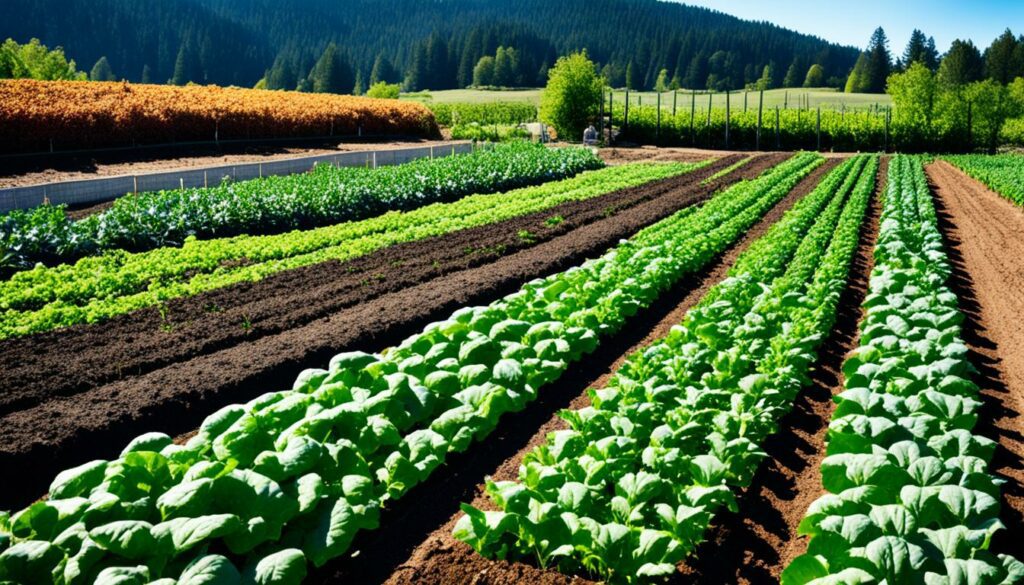
Enforcing regulatory compliance is vital against organic fraud. The USDA introduced the Strengthening Organic Enforcement (SOE) rule. It starts on March 19, 2024. This rule will make sure organic products can be traced from farm to store better. It increases inspections on imports and at certified sites.
| Components | Measures | Impact |
|---|---|---|
| Certification of Traders | Mandated by SOE | Improves market integrity |
| Import Certificates | Required for all organic imports | Prevents fraudulent imports |
| On-site Inspections | Enhanced authority | Ensures compliance with standards |
| Traceability Audits | Conducted by inspectors | Tracks imports against production |
Certifying products as organic is crucial, but it can be expensive. The USDA has strict rules to make sure anything labelled organic meets these high standards. This is not just about stopping fraud. It also gives shoppers confidence in the products they buy. For example, in cases like Missouri farmer Randy Constant, tight certification and checks are key to keep the market safe.
Investing in regulatory compliance and strong certification matters a lot for organic integrity and fraud risks. It’s important for everyone in the organic world to work together on this. This ensures the organic sector can keep growing and stay trusted.
Finding organic seeds is crucial for organic farming’s success. With over $56 billion in organic food sales in 2020, high-quality seeds are in great demand. But, getting the best seeds in both quality and quantity is hard.
The availability of varieties in organic seeds is limited. The market has grown, but not enough to meet rising needs. Many large-scale vegetable growers, working over 50 acres, say they lack seed treatments and enough seed in organic form. This situation shows we need a wider range of strong seed types for organic farming.
Quality and quantity issues in seeds are major worries. Despite a $39.8 million rise in investment in the past five years, we’re not making enough progress. Farmers face issues finding seeds with the traits they need and often not finding enough seeds. Making organic seeds more available and supporting their development can cut farming costs and risks. But, this needs more funding and strict rules to make sure farmers use organic seeds when they can.
Organic farming faces many challenges. Yet, getting technical assistance for organic farmers can help a lot. For example, the USDA NRCS’ EQIP Organic Initiative offers up to $20,000 yearly for certified or transitioning producers. This helps with the costs of conservation practices.
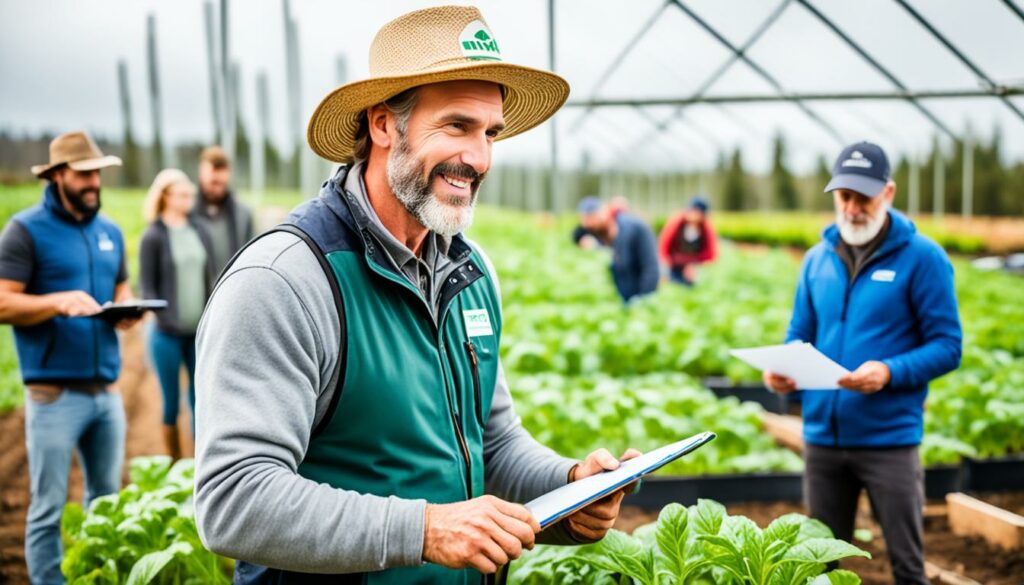
The USDA NRCS provides valuable help for all agricultural producers, including those who are organic. They offer free technical assistance. This assistance is vital for organic farmers, helping them learn and make better choices. ERS also shares important market data, like organic price premiums, to help farmers understand their market better.
Grants from places like SARE are crucial for research and education. They support projects that focus on organic fields. eOrganic adds to this by giving out articles, webinars, and expert advice on organic farming.
Support doesn’t stop there. Programs like Start2Farm and KYF2 connect new farmers to education. The NCAT’s ATTRA shares info about sustainable farming. This helps farmers and educators stay informed.
The USDA and NRCS also help with financial support. Their programmes aid with costs of organic certification and offer conservation help. Making this technical assistance for organic farmers accessible helps reduce challenges. It also inspires more farmers to go organic.
The AJP is another key player. They offer free support and educational workshops. Their goal is to keep the movement towards better farming practices alive and well.
In conclusion, better technical assistance for organic farmers is needed to overcome obstacles. By combining financial support, educational efforts, and market information, we can strengthen the organic farming community. This is essential for the future success of organic agriculture.
Farmers moving to organic methods face special challenges. They must learn new ways of farming and tackle money problems.
Changing to organic farming means using new practices. Many farmers start with cover cropping. This is used by 68% of those asked, much more than non-organic farmers. Intercropping is another option chosen by 31%. These methods help land health, control pests, and make farms more sustainable. Although there are guides, such as those from the USDA, there’s still more to learn.
Moving to organic farming is expensive. Certification costs a lot. It’s a big issue for 31% of those asked, and even more for BIPOC farmers. When farmers start, their first yields might be lower. This can hit them hard financially. Luckily, there are programmes like OCCSP and a big investment in OTI by the USDA. Also, the OMDG has given support for growing markets, offering $9.75 million. These efforts help lessen the financial pressure.
| Factor | Organic Farmers | Conventional Farmers |
|---|---|---|
| Regular use of cover crops | 68% | 10% |
| Practice intercropping | 31% | Uncommon |
| Cited certification costs as a challenge | 31% of all, 58% of BIPOC | N/A |
To switch smoothly to organic farming, farmers need to learn new practices and handle money issues. Support in terms of guidance and funds is available for them.
Racial equity in organic farming is a big issue. BIPOC farmers face more challenges. This includes high production costs, hard-to-get certifications, and little access to money. They also have to meet strict certification rules.
BIPOC farmers are less than 3% of organic farmers. This shows how hard it is for them. For example, Latinx farmers are only 6% of the farm owners. But they make up over 80% of the farm workers. Farms run by Black or African American operators make very little in organic sales. This is much less than the sales by farms with White operators.
The numbers point to serious barriers for BIPOC farmers in the organic industry. It shows why we need to fix this with better opportunities.

We must work on giving BIPOC farmers more help in organic farming. More funds and better advice are key. The USDA Organic Transition Partnership Program helps. So does the Students of Color Organic Career Network. They provide internships in organic groups and certifications offices for BIPOC students.
Training for those who give out certifications, check farms, and teach is crucial. They need to know about the history of race in farming. And they should work to break down big barriers. The National Organic Coalition (NOC) is trying hard to include more diverse groups. They want to help in achieving racial fairness in organic farming.
| Farmer Demographics | % Representation |
|---|---|
| Black, Indigenous, LatinX, Asian American, or Pacific Islander | |
| Latinx Farm Labourers | 80% |
| Latinx Owner-Operators | 6% |
Fixing issues for BIPOC farmers requires a team effort in the organic world. We need more leaders from diverse backgrounds. Plus, we must create fair policies. This is how we make a truly equal future in organic farming.
Organic farming boosts the environment and keeps nature in balance. This method avoids using synthetic chemicals. By doing this, it protects our ecosystems and keeps them healthy. For instance, using organic fertilisers instead of synthetic ones helps keep our water clean. This is because it lowers the risk of polluting our groundwater.
Organic farming is very good for the soil. It makes the soil store more carbon. This helps fight against climate change. Also, it encourages more plants, animals, and important organisms to live. This creates a richer, healthier environment for all.
In Europe, some countries are leading the way in organic farming. For example, Finland, Austria, and Germany aim to have 20 percent of their land for organic use. Organic methods like changing crops, planting more than one kind of crop together, and disturbing the soil less are key. These methods help make sure the soil is strong and can be used for a long time.
In places where agriculture is growing fast, organic farming is proving to be very useful. In India, for instance, farmers are mixing different crops and manually adding legumes to the soil. These methods have led to better farming results and less pollution. They show how organic farming is great for all kinds of farming areas.
Choosing organic farming helps save the areas around farms too. This makes the land more welcoming to helpful creatures. These creatures can control pests and help in the pollination of plants. Evidence from many studies shows that organic farming is the best at keeping our natural world diverse. This is crucial for the future of farming and our food.
Organic agriculture is growing fast worldwide. Around 26 million hectares are under organic farming. Yet, it faces big problems. These include dealing with weeds, pests, and diseases. Plus, keeping the organic label true is tough. Adding to this, climate change poses new challenges for this kind of farming.
Organic farming leads to water and air pollution due to the use of manure. This affects soil health. About 52% of farm soils globally are in bad condition. This highlights the need for sustainable farming. Solutions are vital, especially since we use so much freshwater. And in organic farming, saving water is key.
People want more organic food, especially in places like Bangalore. Many are learning through education programmes there. For instance, farmers near Kanakapura Road are using smart pest control methods. This shows progress. To fully benefit from organic farming, we need more research. Also, support for farmers and strong yet fair certification systems. The aim is to tackle farming challenges while making the industry more fair and green.
Organic farming faces several key challenges. These include managing weeds organically, dealing with pests and diseases by natural means, and keeping the soil healthy without artificial fertilisers. It’s also hard to control costs and adapt to changing weather patterns.
Managing weeds without chemicals is hard. Organic farmers must use techniques like cover cropping. But these methods are both expensive and time-consuming.
Organic farmers avoid harsh chemicals. They use methods such as not tilling too much, planting cover crops, and mixing crops together. This helps the soil stay rich and keeps it healthy.
Dealing with bugs and plant diseases without harsh chemicals is tough. Organic farmers often use natural pesticides and encourage helpful bugs. But these methods can cost more and might not work as well.
Climate change seriously affects organic farming. It can lead to unusual weather that damages the crops. To fight this, organic farmers are using less water, growing different kinds of crops, and making their soil stronger.
Finding the right organic seeds can be tough. The demand is rising, but they’re still hard to get. This makes it difficult for organic farmers to start or continue their work.
Organic farming costs a lot because it’s more hands-on and requires certification. Despite their higher selling prices, these costs make it hard for farmers to make a profit.
Keeping organic products truly organic is very important. Strict rules and regular checks are needed. This makes sure that both farmers and buyers can trust organic products are what they claim to be.
Help with farming methods and selling organic products is vital. It makes it easier for farmers to do well in organic farming. More support and training could encourage others to join or stay in the field.
BIPOC farmers often have less money, find it tough to get financial help, and may struggle more with the rules. Offering more help, funding, and reaching out to them can help make things fairer in organic farming.
Organic farms do a lot for the planet. They use fewer artificial chemicals, which is good for wildlife and the health of the soil. They also try to let the animals live and eat in more natural ways.